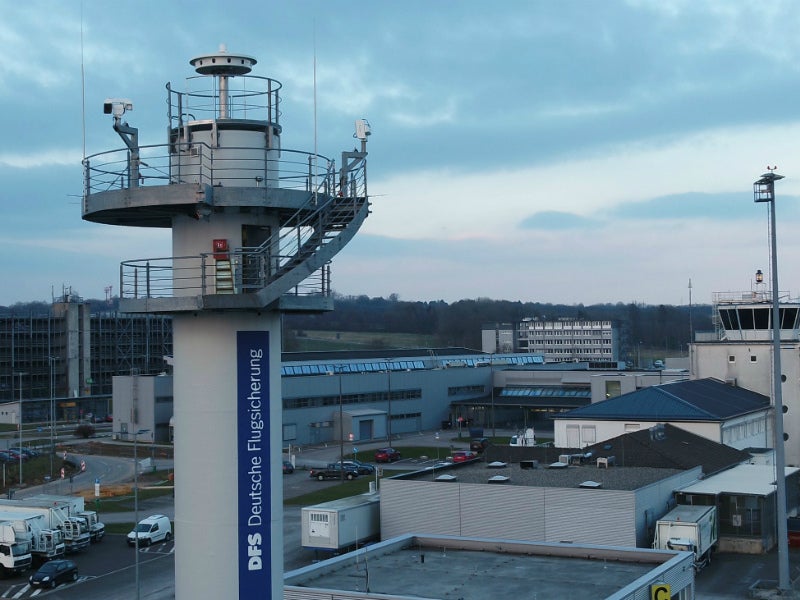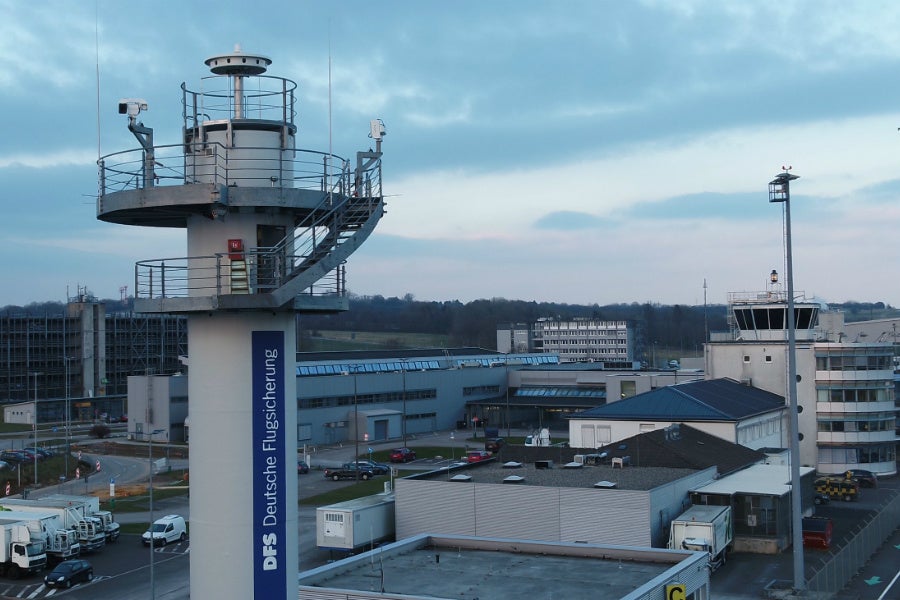
The concept of using a multitude of local sensors and cameras feeding information back to high-definition screens located elsewhere has a number of use cases and setups. Screens could be located downstairs in the same building at the airport or miles away. A remote tower can be in place as a contingency measure or in use as a secondary system for vision enhancement, but the system in place for DFS is classed as a real remote tower system, with the remote tower located in a completely separate location from the airport.
The Frequentis solution gives operators full visibility of the runways at Saarbrücken Airport in the state of Saarland near the border with France using a 360° camera system installed on masts around the airport, with pan-tilt-zoom function and infrared sensors.
Frequentis DFS Aerosense head of sales, Peter Gridling, spoke to us about the development of the project. “Saarbrücken has been in operation since 4 December 2018, without any disruption. We have also had the opportunity to receive feedback from the controllers, and it was very positive,” Mr Gridling says. “Controllers were trained on the new system and also brought up ideas for improvement but overall the concept has been proved to be safe and reliable to remotely manage air traffic.”
With over 15,000 flight movements per year, Saarbrücken is currently the largest airport in the world where daily operations are controlled remotely.
Standardisation of remote control tower technology
Remote towers offer a number of benefits compared to conventional air traffic control towers at airports. “Basically, it provides additional support tools for the controller and this creates a safety enhancement,” Mr Gridling highlights. “When we are talking about our augmented reality features, automated object detection and virtual safety nets, then those are features that cannot be implemented into a conventional tower.”
Frequentis DFS Aerosense is focused on developing RT technology across the world with its potential benefits. “In 15 years, we will see this technology at every airport worldwide, even the biggest ones, of course all with different use cases,” Mr Gridling explains. “For the biggest ones, it will be more of a contingency service or a vision enhancement, but the same technology will be there.”
Frequentis has been developing additional functions for its remote towers, including object detection. “We have developed the first generation of this feature with Saarbrücken Airport being the first airport worldwide using it operationally,” Mr Gridling comments. “Frequentis is already working on the second generation, using the detected object to provide virtual safety nets.”
DFS and Frequentis have been working on RT technology for four years, putting it through live operating condition tests. The companies joined forces to create Frequentis DFS Aerosense in 2018, after the successful project in Saarbrücken, building on the delivery of the RT concept. The joint venture combines Frequentis’ technical expertise with the German ANSP’s operational air traffic control experience.
The company has been heavily involved in defining RT technology standards within the European Organisation for Civil Aviation Equipment’s (EUROCAE) Working Group 100 (WG100), which comprises RT technology suppliers that have been tasked with defining basic requirements for safe operation.
Mr Gridling explained the importance of Frequentis’ role in WG100, which is working on EUROCAE Document 240, mainly the 240A version. “The A version of the document describes all the advanced features, which are now implemented in Germany,” he says. “Because Frequentis has developed these advanced features, we have been in the lead writing the A version of the document. It defines the minimum requirements that remote tower technology has to fulfil to be safely implemented at an airport.”
Controlling multiple airports from one remote tower
In addition to standard RT solutions, Frequentis is one of the leading companies participating in SESAR multi-remote tower technology testing, which involves multiple airports being controlled from one remote location.
Earlier this year, the company carried out the sixth multi-remote tower testing in collaboration with Hungarian ANSP HungaroControl, but for the first time in a real situation rather than a simulation. “We have controlled three airports; Budapest, Debrecen and Papa from one controller working position,” Mr Gridling explains. “This validation took place in a real environment and this was the first time it was executed at real airports with real cameras, real networks, real traffic.
“Multi-tower remote operation is only possible with additional support tools like a multi-airport planning tool and radio squelch indication, so the findings from us and our competitors were that basic remote towers cannot execute multi remote tower operations.”

Testing multi-remote tower systems is similar to a normal remote tower implementation. Controllers are trained on the technology with the camera systems installed at multiple airports. Controllers have three window display screens, as well as one screen for the pan-tilt-zoom camera, displayed in a row for each airport to facilitate simultaneous operation.
Allowing multiple airport operations to be managed by one air traffic controller can offer a number of benefits. “Multi remote tower is especially helpful for airports with very low traffic numbers, so airports with 3,000-6,000 movements per year,” Mr Gridling tells us. “The major benefit is there are many regions in the world where the airport is not operated with profit, even at a loss and risk closure. You could therefore operate those much more economically if you do not need controllers at every airport and instead combined tower services for three low traffic airports at the same RT facility.
“For very small airports, it is a safety enhancement because they are often providing only aerodrome flight information service (AFIS). The AFIS officer typically doesn’t have a tower, only a radio communications with the pilot. It is the pilot’s responsibility to check if the runway is free because the officer cannot see. Remote tower technology solves this issue by giving the AFIS officer a clear view of the runway and the arrival and departure sector.”
Worldwide remote control tower implementation
Frequentis has been involved in a number of remote traffic control tower projects worldwide, with ANSPs in Brazil and New Zealand selecting Frequentis’ solution in March 2019.
Mr Gridling spoke about the company’s ongoing RT projects. “This year, we will set into operation the mission enhancement and contingency system for Ezeiza Airport in Argentina,” he adds. “Then we have our two most recent projects, the one in Brazil the project in Santa Cruz, which is both civil and military, and our project in New Zealand, which will be an advanced remote tower in Invercargill.
“We have also the first military programme for the Department of Defense in the US. There we are currently delivering four remote tower systems, two of them fixed and two of them deployable, for the US Air Force and other Department of Defense agencies.”
Currently, there are four operational Frequentis remote control towers across the world, including the Saarbrücken tower. “Jersey in the UK has implemented a contingency system,” Mr Gridling explains. “In the northern part of Iceland at Akureyri, we are testing the technology for severe weather conditions. Then we have a vision enhancement system in Vienna.”
As part of the company’s research, it is using artificial intelligence (AI) to classify objects. “The systems will be in the position to classify the different objects based on their behaviour,” Mr Gridling says.
Another obstacle with using AI is how to train the system. Normally, AI learns from experience. “When you want to train irregular situations, that is extremely hard because those situations only seldom occur at an airport,” he continues. “Currently, with the existing technology, AI is not really safe to use at an airport and that’s what we would like to change.”
With the research and development of new advanced technology used in remote control towers, Frequentis has established itself as a leading company in the aviation industry. “I think we have proven that Frequentis is now really recognised as the remote tower specialist,” Mr Gridling adds.


